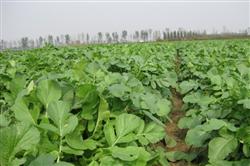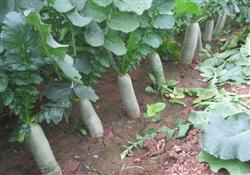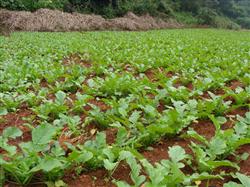How can summer radish be planted with high yield?

How can summer radish be planted with high yield? Please introduce planting methods for planting summer radish if you want to obtain high yield, you can refer to the following planting methods: first, the selection of improved varieties and selection of good varieties is a prerequisite for high quality and high yield of summer radish. Therefore, early maturing varieties with good heat tolerance and strong stress resistance must be selected when cultivating radish in high temperature season in midsummer and early autumn. Second, the growth period of precocious radish with sufficient basal fertilizer is short, and the requirement for nutrients is high, combined with soil preparation. Base fertilizer should account for 70% of the total fertilizer application, and 4000 kg of fully mature farm manure and 30kg of compound fertilizer can be applied per mu. Radish should be cultivated in deep trench and high border, which is 25cm high and 30cm high. Third, when sowing seedlings and cultivating radish in summer and early autumn, the radish can be sown in batches from May to August according to the market demand in summer and autumn. Sowing methods include on-demand sowing and sowing, which can be reasonably selected according to the type of variety. Large fruit type varieties should be sown on demand, plant spacing is 20 cm, row spacing is 35 cm, sowing holes should be shallow, and fine soil should be used to cover seeds after sowing. Small fruit type varieties can be sowed and keep a plant spacing of 6 cm to 12 cm after seedlings. After sowing, straw can be used to cover the border to prevent sunburn, rainstorm erosion and reduce the loss of fertilizer and water. The border surface can also be covered with a sunshade net, which is conducive to the emergence of the whole seedling, which should be removed in time after completing the seedling, so as not to press the seedling or cause the seedling to be weak. Pay attention to the seedling stage must be early seedling, late seedling. The seedlings grew rapidly after being unearthed, and the seedlings were fixed at the stage of 5-6 leaves when the seedlings grew 1-2 leaves and 3-4 leaves, respectively. Fourth, fertilizer and water management radish needs more water, and the amount of water is closely related to the yield and quality of radish. Too much water, radish rough skin, but also easy to cause root cracking and rot; lack of water in the seedling stage, prone to virus disease. When lack of fertilizer and water, radish fleshy root is small and woody, bitter and spicy, easy to bran heart. Cultivation should be based on the characteristics of each growing period of radish and the need for water balanced water supply, do not suddenly dry and wet. Water enough after sowing, and most of the seeds should be watered again after emergence to benefit the whole seedling. After planting, the seedlings will soon enter the peak period of leaf growth and should be watered appropriately. In the later stage of vegetative growth, water should be properly controlled to prevent excessive growth of leaves and affect the growth of fleshy roots. When the plant grows 12-13 leaves, the fleshy root enters the period of rapid growth, at this time the supply of fertilizer and water should be sufficient, and it can be watered flexibly according to the weather and soil conditions. It must be drained in time after heavy rain to prevent excessive water retting, resulting in split or rotten roots. High temperature and drought season should adhere to the evening watering, do not water at noon, to prevent tender leaves withered and fleshy roots rot, stop watering 7 days before harvest. Radish also has special requirements for nutrients, boron deficiency will make the fleshy root black and bran heart. In the period of fleshy root expansion, potash fertilizer should be applied properly, after emergence to before seedling setting, a small amount of fertilizer should be applied when the seedlings grow 2 true leaves, and once after the second interseedling combined with intermediate ploughing and weeding. During the period from "breaking white" to "bare shoulder" of radish, the second topdressing was carried out, and the appearance of seedlings was looked at later. It should be noted that topdressing should not be close to the fleshy root so as not to burn the root. Weeding in the middle tillage can be combined with irrigation and fertilization, the middle tillage should be deep and then shallow, near and then far, and stop the middle tillage after closing the row. Click for more radish planting techniques click to get more vegetable planting techniques
- Prev

How to plant radish in summer?
How to plant radish in summer? Please introduce the method of planting summer radish with reference to the following methods: 1. The selection of improved summer radish cultivation should choose early-maturing varieties with good heat tolerance and strong stress resistance, such as red pill 20-day radish, flower radish and so on. two。 The growth period of precocious radish is short, right.
- Next

What are the management methods of growing radish in summer?
What are the management methods of growing radish in summer? The summer planting of radish can be managed with reference to the following methods: 1. Seedling, fixed seedling: after the seedling is unearthed, the first seedling is carried out when the cotyledons are unfolded, and the second seedling is carried out after growing 3-4 true leaves. When the seedling has 5-6 leaves, the fleshy root of radish is broken.
Related
- Where is it suitable to grow horseradish in China? it is expected to see the middle altitude horseradish in Alishan.
- How to prevent tomato virus disease reasonably? (Control methods included)
- Many people like to plant towel gourd on the balcony. What are the main points of this method and management?
- What crops can chili peppers be mixed with?
- Fertilization techniques and matters needing attention in Tomato
- What are the grafting techniques for peach seedlings in spring?
- Harm and control methods of root swelling disease of Chinese cabbage
- What are the pests of sweet potatoes? How to prevent and cure it?
- Symptoms, causes and Control methods of navel Rot in Tomato
- The cause of "Cucumber rotten bibcock" in Farmers' planting Cucumber and its Control Plan

